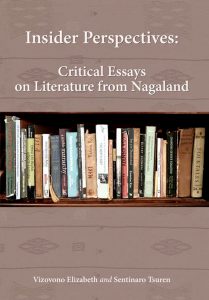Book Reviews
Insider Perspectives: Joining the Pursuit of Textualizing the Naga Condition
By Dzüvinguno Dorothy Chasie

Book: Insider Perspectives: Critical Essays
on Literature from Nagaland
Author: Vizovono Elizabeth and SentinaroTsuren
Norway: Barkweaver Publications 2017, 1-210
Price: Rs. 300/-
(Available online at www.ilandlo.com)
Overview
Insider Perspectives is a collection of critical essays composed and compiled by the two authors, Vizovono Elizabeth and SentinaroTsuren, and aims to stand as a ready secondary material produced by Nagas on Naga Literature for the first time. Both of them, lecturers at Baptist College, Kohima, recognized the dire need for concrete analytical reference material on Naga Literature, for students and researchers alike, and thus, came up with the concept to begin this endeavor. The book covers important Naga writers who write in English such as NiniLungalang, EasterineKire, and TemsulaAo, some of whose works have been included in the undergraduate-level syllabus in the State and some even gaining national and international repute in the recent years. These sixteen essays, divided into two sections, not only pose as answers on how to approach a literary text especially of Naga origin but also to encourage other Nagas to produce quality critical as well as creative material.
The Book: Contribution and Relevance
Nagaland is a state whose literary history is only on the brink of formation, having been initially following the oral tradition of passing down information; this includes values, ritual rites, folklore, folk songs, and dances. VeioPou shares the opinion that the Naga literary tradition has seriously begun only at the turn of the last century and still has much room to be explored. The urgency of a proper literary tradition of the Nagas is essential today more than ever– to document the past as well as to question the present- as the twenty-first century has marked a ‘coming of the new’ and ‘dying of the old’: an influx of Western values and commodities, resulting in the biggest one-sided commercial boom since the beginning of “civilized” Naga Society. This is leading to rapid alterations in the value system of a people that risk losing the ‘Naga Identity’ which will not be able to be salvaged at any later time. This information is relevant, as one of the authors rightly referred to Mathew Arnold and how he stated that critical activity must go hand in hand with creative activity; and it is only with critical activity such as this book that will stand to inspire a better understanding and discovery of the relevance of the Naga literature produced today.
The essays are divided into two sections – the first section comprises of critical essays by co-author,Vizovono Elizabeth. These eight essays concentrate on the critical study of fiction works by Naga authors such as Easterine Kire and Temsula Ao,and two essays on the works of Naga women poets such as NiniLungalang as well as of lesser known poets. The essays on fiction give fresh perspectives on both specific works like A Naga Village Remembered and A Terrible Matriarchy, as well as spatial aspects on Naga Literature in essays such as “An Overview of the Development of Literature in Nagaland”, “Negotiating a Meaningful Existence: The Quest of Identity in Contemporary Naga Narratives”. The nature of these essays is critical and marks a proper beginning towards the search of especially postcolonial elements in the idea of the “Nagas” both in Naga History and search of Naga Identity.
The second section of the book consists of eight essays by Sentinaro Tsuren that are concerned with not only analysis of Ao Naga folktales and songs but also the documentation and translation of works from the Ao Naga dialect to the English language. The essays, therefore, carry the weight of translated and documented works, some translated by the co-author herself, of oral stories and information passed down through the ages and making a critical study on them. The essay such as “The Art of Orality, Narratology and Story Telling: An Overview” and its relation to culture and both personal and group identity. Other essays pertain to the Ao Naga society, oral literature as in “Folklore as Cultural History: Re-reading JinaEtiben” and also its reflection in works of TemsulaAo such as in “Myths, Beliefs, and Customs in TemsulaAo’s Songs from the Afterlife”. The last essay contains a documented interview between the co-author and TemsulaAo, on her style of writing as well as on some of her published works.
In conclusion, although the book appears to be a humble sign of progress of Naga literature and analysis by Nagas, it also marks the beginning of a proper movement towards the larger potential that Naga literature possesses, and the many discoveries still to be made. In a sense, it challenges the Nagas, especially the many English Literature students being churned out from colleges in the State every year, to rise to the occasion and henceforth continue the quest for answers on the meaning behind the word “Naga”.

